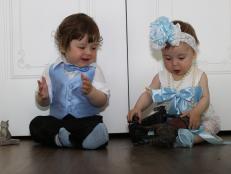A Speech Therapist Explains When You Should Worry About Your Baby Talking
While all babies develop at different times, here are a few signs a speech therapist thinks you should watch out for.


SDI Productions
Hearing your baby’s first word is such a sweet milestone for parents. Listening to those early babbles and coos turn into words, like mama or dada, is music to our ears. As your baby’s language begins to develop, you may find yourself comparing their speech to that of other babies their age, or an older sibling when they were the same age. If you are on a playdate and find a chatty toddler, you may question if your little one is saying enough words.
As any pediatrician or speech therapist will tell you, there is a wide range of what is considered "normal" when it comes to speech development in children. So, we talked to Speech Therapist Abbie Argirakis, from Vantage Speech Therapy, about the signs parents should be on the lookout for — and when they should seek help for their child.
- If your child is mainly using gestures or pointing instead of talking, it’s time to get chatty with them. Argirakis says, "This becomes a larger issue when parents consistently give in to their children by not encouraging vocalizations of wants and needs. Modeling the word/action is always a good way to encourage vocalizations of a word." So, if your child wants a drink of water and hands you a cup or points to the water, encourage them to use their words by saying "water" or "drink." If they hand you the cup for seconds, say "more water" or "more drink" to encourage them to use their words. As you go about your day with your baby, be sure to narrate everything you are doing. For example, "Mommy is petting the dog. Nice dog. Do you want to pet the dog?" Narrating simple tasks, chores, and everyday objects is a great way to encourage your child to mimic you and start using their words.
- If your child is not consistently responding to their name (especially if they are over the age of one), Argirakis recommends speaking with your pediatrician.
- By 18 to 24 months, your pediatrician will be looking for your child to combine two words, such as "mama sit" or "dog jump." Again, it’s important to model this for you child — no need to give long and wordy descriptions. Instead, offer up two-word commands or requests, like "baby hungry" or "more music" to help encourage your child to use two words together.
- While it can be adorable when little ones mispronounce words or sounds, there are several sounds children should be producing. According to Argirakis, "Although it is normal for young children to say some sounds incorrectly, it should be monitored for your child to be able to produce p, b, m, h, and w correctly most of the time between the ages of 1-2 years." She adds that by the age of 2-3 years, "your child should have developed appropriate production most of the time for k, g, f, t, d, and n sounds."
- If your child is experiencing frequent ear infections, it’s not only painful, but can affect their speech development. "Children’s language can only develop if adequate hearing is possible. When a child has ear infections, it can often make it sound like they are 'under water,' where all speech sounds are muffled," Argirakis says. If a child has frequent ear infections, high-frequency sounds could completely disappear. Argirkis explains that a child may perceive a word to be produced without those high frequency sounds, like "sun" could be heard as "un."
- Developing language can be a frustrating process for you and your little one. It’s important not to withhold items from your child until they say the word, or allow your frustration (or theirs) to lead to anger on your part (or tantrums for them). Instead, take a deep breath, get down to their level, and help your child practice verbalizing their needs.
If you are looking for more advice and help with your child’s language use and development, ask your pediatrician for a recommendation or search your area for speech therapists. Often, if children meet certain requirements, there are free services available.















